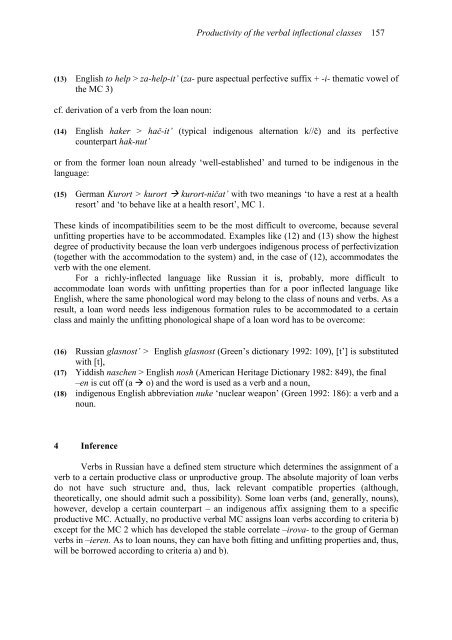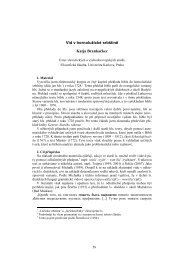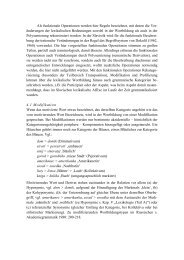Productivity of the verbal inflectional classes
Productivity of the verbal inflectional classes
Productivity of the verbal inflectional classes
Create successful ePaper yourself
Turn your PDF publications into a flip-book with our unique Google optimized e-Paper software.
<strong>Productivity</strong> <strong>of</strong> <strong>the</strong> <strong>verbal</strong> <strong>inflectional</strong> <strong>classes</strong> 157(13) English to help > za-help-it’ (za- pure aspectual perfective suffix + -i- <strong>the</strong>matic vowel <strong>of</strong><strong>the</strong> MC 3)cf. derivation <strong>of</strong> a verb from <strong>the</strong> loan noun:(14) English haker > hač-it’ (typical indigenous alternation k//č) and its perfectivecounterpart hak-nut’or from <strong>the</strong> former loan noun already ‘well-established’ and turned to be indigenous in <strong>the</strong>language:(15) German Kurort > kurort kurort-ničat’ with two meanings ‘to have a rest at a healthresort’ and ‘to behave like at a health resort’, MC 1.These kinds <strong>of</strong> incompatibilities seem to be <strong>the</strong> most difficult to overcome, because severalunfitting properties have to be accommodated. Examples like (12) and (13) show <strong>the</strong> highestdegree <strong>of</strong> productivity because <strong>the</strong> loan verb undergoes indigenous process <strong>of</strong> perfectivization(toge<strong>the</strong>r with <strong>the</strong> accommodation to <strong>the</strong> system) and, in <strong>the</strong> case <strong>of</strong> (12), accommodates <strong>the</strong>verb with <strong>the</strong> one element.For a richly-inflected language like Russian it is, probably, more difficult toaccommodate loan words with unfitting properties than for a poor inflected language likeEnglish, where <strong>the</strong> same phonological word may belong to <strong>the</strong> class <strong>of</strong> nouns and verbs. As aresult, a loan word needs less indigenous formation rules to be accommodated to a certainclass and mainly <strong>the</strong> unfitting phonological shape <strong>of</strong> a loan word has to be overcome:(16) Russian glasnost’ > English glasnost (Green’s dictionary 1992: 109), [t’] is substitutedwith [t],(17) Yiddish naschen > English nosh (American Heritage Dictionary 1982: 849), <strong>the</strong> final–en is cut <strong>of</strong>f (a o) and <strong>the</strong> word is used as a verb and a noun,(18) indigenous English abbreviation nuke ‘nuclear weapon’ (Green 1992: 186): a verb and anoun.4 InferenceVerbs in Russian have a defined stem structure which determines <strong>the</strong> assignment <strong>of</strong> averb to a certain productive class or unproductive group. The absolute majority <strong>of</strong> loan verbsdo not have such structure and, thus, lack relevant compatible properties (although,<strong>the</strong>oretically, one should admit such a possibility). Some loan verbs (and, generally, nouns),however, develop a certain counterpart – an indigenous affix assigning <strong>the</strong>m to a specificproductive MC. Actually, no productive <strong>verbal</strong> MC assigns loan verbs according to criteria b)except for <strong>the</strong> MC 2 which has developed <strong>the</strong> stable correlate –irova- to <strong>the</strong> group <strong>of</strong> Germanverbs in –ieren. As to loan nouns, <strong>the</strong>y can have both fitting and unfitting properties and, thus,will be borrowed according to criteria a) and b).




